Even when Im trying to live under my rock, I still am somehow flooded with news that there was a slap fight.

No not this Will Smith Chris Rock thing, I’m talking of course about Clive Sinclair slapping Chris Curry at the Baron of Beef pub in Cambridge.
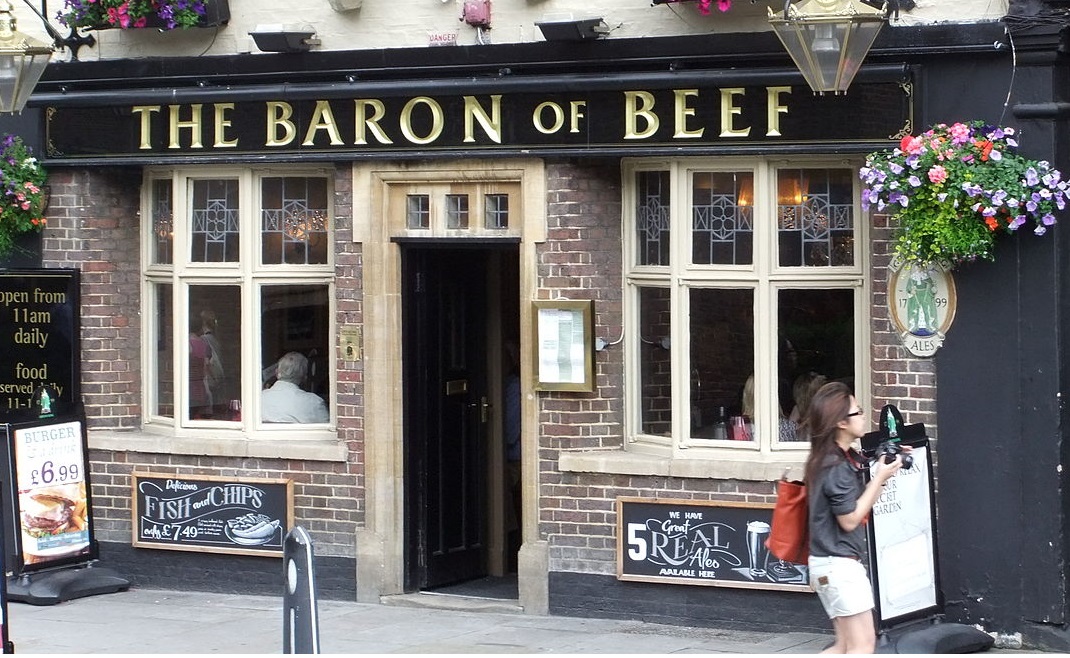
Where’s the beef?
As the legend goes, Curry worked under Clive, but he ran into Herman Hauser who had encouraged Curry to go his own way and make that computer of his dreams. Incised about this Clive was able to put together and rush out the Z80 before Acorn had anything ready to ship
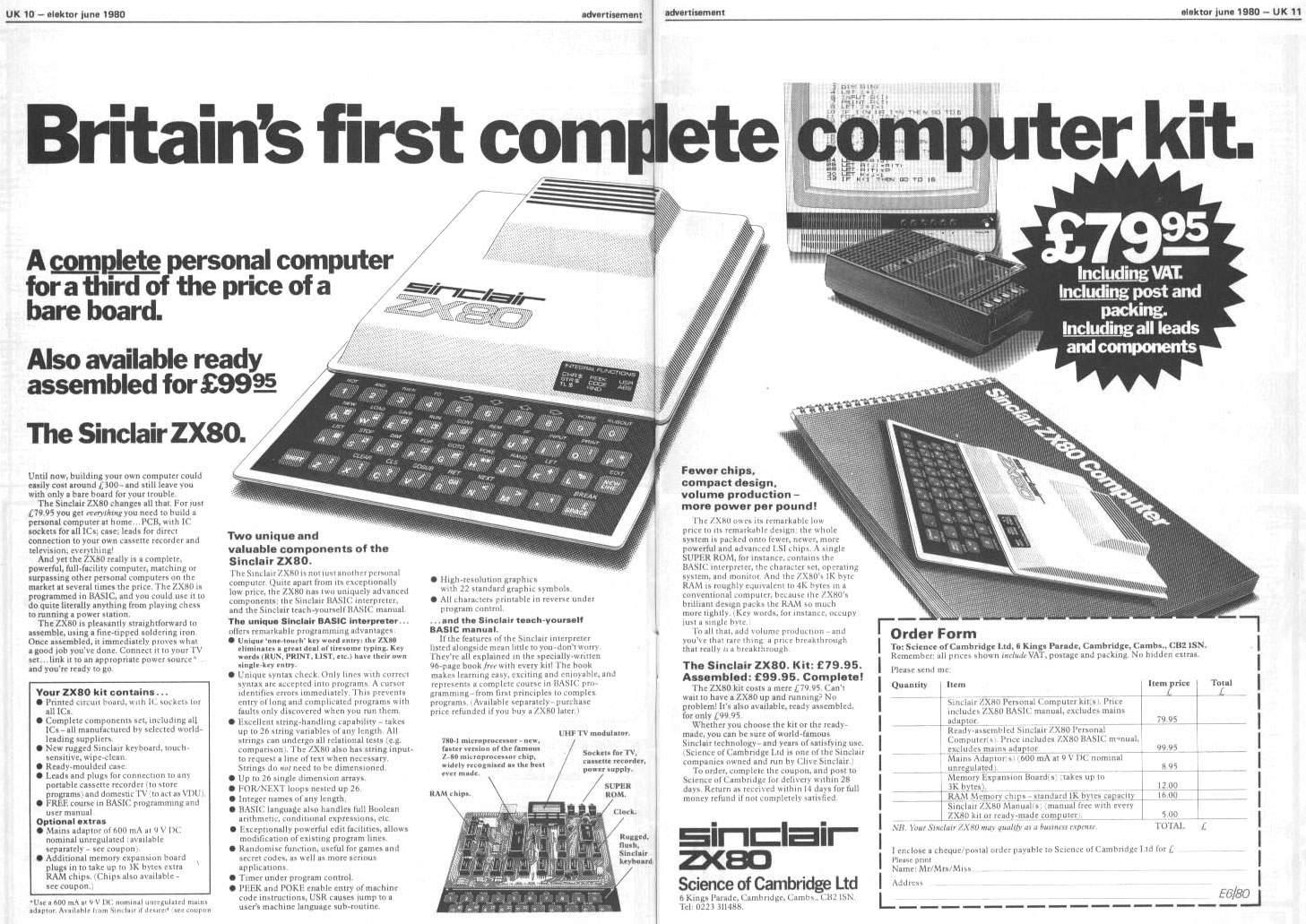
And more importantly it was CHEAP. You’d have thought that the zx80 would have found a larger world wide market but Commodore and Apple reigned supreme in North America.
Later that year Acorn would ship the Acorn Atom priced around £129 in kit, and £179 assembled it was a lot more expensive but granted it did have a lot more ‘computer’ in there.
In the following year Sinclair had released the ZX81, which although a larger price point also included a lot more, larger ram/rom better display and of course this was ready to ignite the coming war.
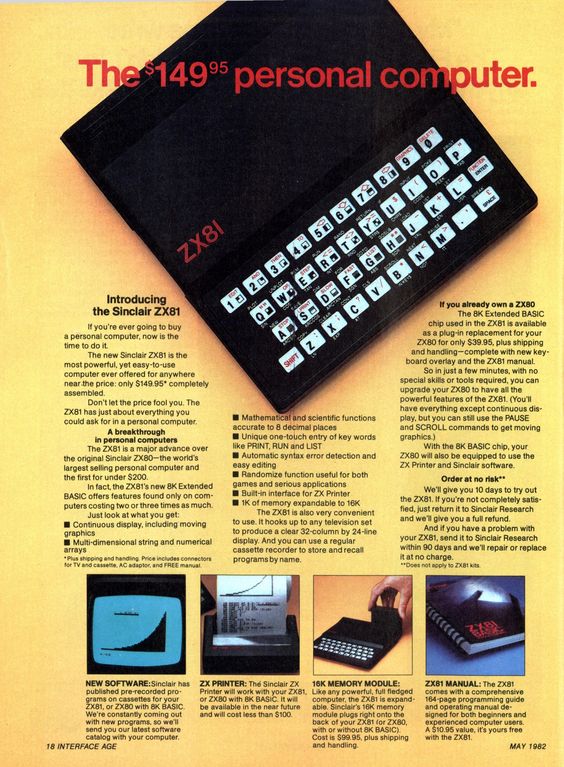
As the legend goes a TV show of all things, ‘The Might Micro, (2/3/4/5/6)’ had ignited such a storm in parliament that the Department of Industry & the BBC decided that they were going to produce programming to go along with a selected microcomputer. And that machine was the Newbury NewBrain… until it was obvious that this wasn’t going to be the machine of choice, and the selection was pushed back from the fall of 81 to the spring of 82. With the BBC being forced to open up selection to other UK computer manufacturers, both worked hard for a machine, however Curry swooped in with his new ‘BBC Micro’ (that had started working the day of the inspection) and won the contract.
1982 of course would give us the ZX Spectrum as Sinclair’s answer to what the people needed.
Oddly enough things in the long term didn’t work out for ether of them, as they both made so many missteps that they ended up ultimately shelving both of the units, with Acorn barely surviving, although their ARM processor does live on, mostly because it ended up free of any hardware platform to go along with it.
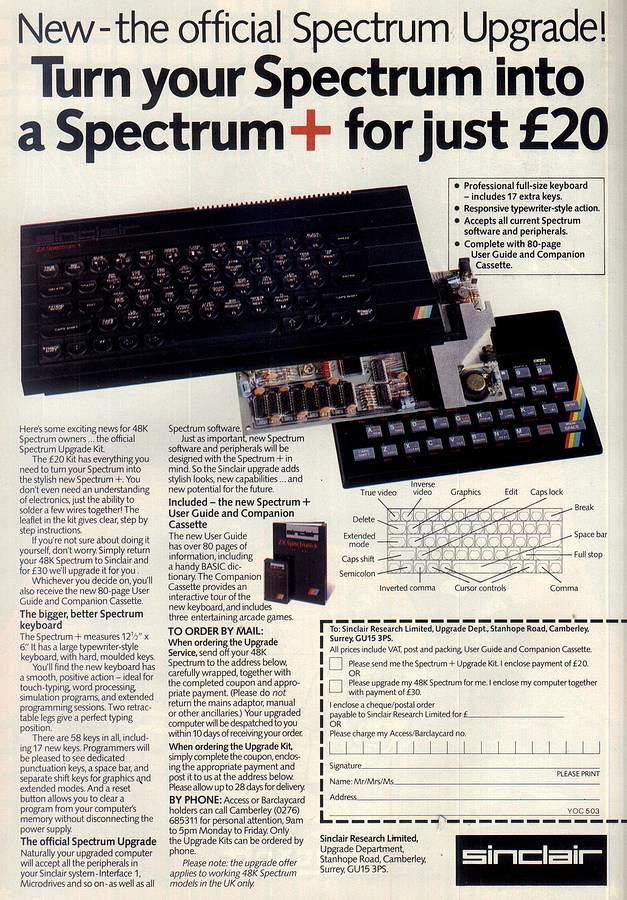
There was no ZX 83 model, instead there was of course the QL for 1984. And taking on the design of the QL the Sinclair + was launched. And despite the name, it was just a 48k with a reset button and nicer keyboard. Very NON plussed. The only upgrade to the ZX would have to come from spain in the form of the 128.
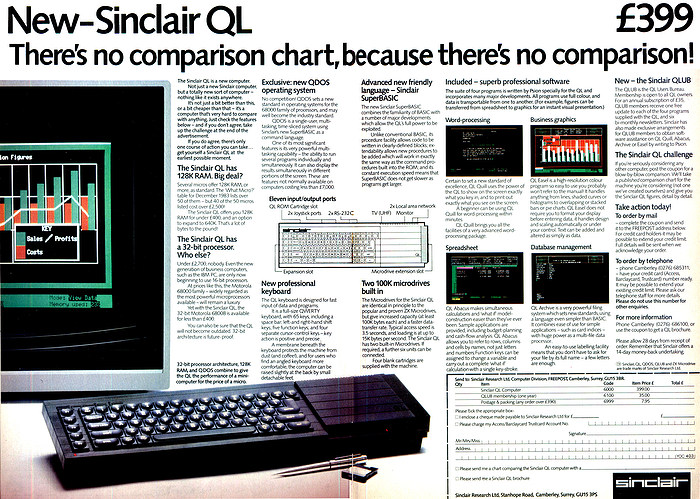
The QL was 100% incompatible with the ZX. Apparently doing something like the SEGA Megadrive, by including both a 68000 and z80 was just too out of the question. Instead it was so focused on price it made the machine not serious enough for the serious business market Clive had craved so much. No socket for a 68881, and the drives being so incredibly tiny, IBM had quickly followed up the PC with the XT which allowed for a hard disk, while the QL with a single slot in no way could fit a then 5 1/4″ full heigh disk.
Although many fault the QL for having relied on the 68008 processor remember even IBM was using the 8088, with the same 8bit constraints, it’s not that it was impossible, it’s that the sleek stylized deck of the QL was just far too ahead of itself, it’d be fine for today, just look at the Pi400! I’d prefer to have one with SD cards up front but I guess I need to learn how to 3d print and make my own.
Another fault of the QL was not having the space on the motherboard to go to the full 1MB of addressable RAM like the PC, and loading the OS from disk. Having the OS in ROM was such an 8bit holdover when loading it from tape would have been useless but the PC way of loading the OS from disk was the way to go, also it far easier facilitated updating. I know the ST & Amiga also went with OS in ROM thinking it saved money but in the long term all the wedge’s of the era just limited themselves.
The real slap: in the market

The real slap that was heard was the stagnation of both machines, and the decline of the UK computer makers. Acorn had apparently manufactured a tonne of Electron’s for Christmas but the order wasn’t actually put through because of some ‘pull back of a video game crash’ in Europe. I guess it’s the continuation of the video game crash in the USA, but as you can see the stockpile of machines to be blown out was just incredible.
And it was in 1984 that apparently Acorn had run an ad showing that Sinclair computers had a high defect rate, something that has always plagued Sinclair’s quest for low cost machines, Something that had been hand waved as a 1 year replacement policy with many teenagers abusing the machines, that led to the confrontation in the Baron of Beef along with the whooping Sinclair had unleashed on Curry. Although much of this has passed into more legend than fact, even Ruth Bramley didn’t recall anything about the event.
It’s an amazing flash in the pan, that has so many games, and so much early computer culture that was partitioned to a tiny island and for the most part in the rest of the world totally unknown. I hope to get a real Spectrum 128 one day, it sounds like a fascinating machine. Although they made a million? of them, they are quite expensive in any market place. I wonder sometimes if there is demand for a super cheap almost ‘disposable’ 8bit computer. Obviously it’d have be under £20.
Since all this UK micro computer stuff never really left the island it’s all new to me. And maybe many people outside of the UK, or surprisingly the iron curtain where zx spectrums were abundant.
footnote: I know people will say that there was some attempt at selling Sinclair Micros out of Texas with one OEM, but honestly I’ve never hear or seen of any such thing, it’s only recently as a curiosity on youtube. And they were incompatible anyways so whatever.
Also holy crap so an actor slapped another actor in a show where they backslap each other. Who cares?! Bring back Beavis and Butthead, and prime time boxing! People obviously have a thirst for this, why did the WWF’s kayfabe fade? the paywalls?

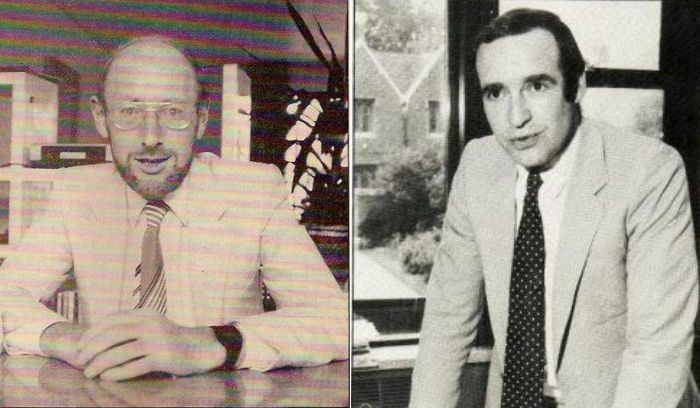
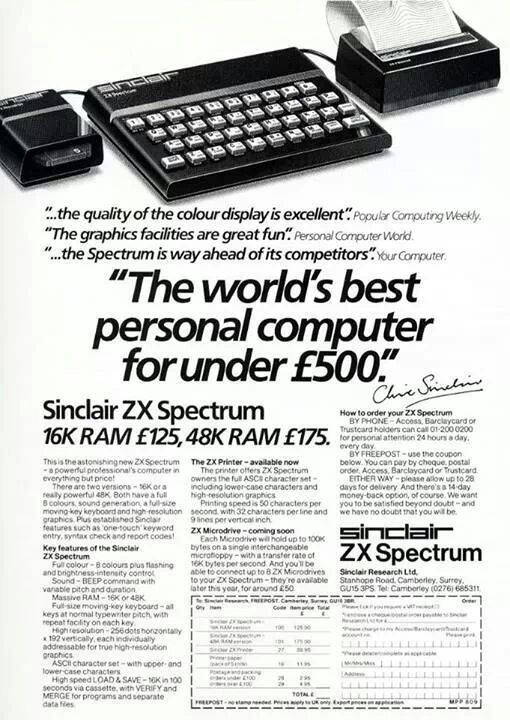
A friend of mine from Idaho used to have a Timex Sinclair 1000 he got from school or something else getting rid of old computers, so I always assumed it had at least some market penetration in the US. Guess it could have been a one-off lowest-possible-cost purchase that did not see wider usage.
PS. Your comment form seems break if the e-mail uses an IDN
I’m sure stuff like IDN’s and unicode break it, as the amount of spam comments I get is nothing short of astronomical. When it went over a thousand a day I had to do something about it being more on the deny side than permit. Which I know really sucks.
With audio cassettes being so cheap to produce for mailing Im surprised it didn’t catch on pre-internet. It’d have been better for some kind of tape to disk program set, although it’s weird just how much people refused to buy peripherals for computers, outside of joysticks.
Timex Sinclair sold more than 500,000 T/S-1000s in the US. Timex was slow in modifying Sinclair’s designs so price cuts to components meant competitors could offer a better computer for about the same price. Timex was also very slow in providing accessories so the necessary RAM expansion was unavailable until the price war made the VIC-20 cheaper than just the 16K RAM expansion from Timex.
The QL has several problems. Announcing the release shipping in 28 days without a working prototype never ends well. The 68008 cost the same as the 68000 in 1984. The microdrives weren’t close to reliable until 1986 but businesses want to store data immediately.
I keep hearing that number of half a million but there would be some kind of residual evidence of it, if it was anywhere near that many. The lack of either praise or condemnation of the machine makes me wonder if it was another miniscribe/brick factory thing, or if they made that many and they got crushed and sent to visit ET.
Also being software incompatible meant that there was zero software, and again if there really was .5 million you’d think some UK software houses would want that easy market as there was such a low bar to get into there, and yet it never happened. So where was all the UK software houses on this half a million installed base just waiting for software?
Announcing the QL far too ahead of time to get in front of the Macintosh was silly, but it was far too 8bit feeling to go anywhere, and those microdrives were just far too small. A 360kb disk drive would have gone a LONG way, just as having the OS in disk would have helped shipping that part ASAP as all you need to do is initialize the hardware and load a bootblock. Again Sinclair was too evolutionary with spite on the QL, not revolutionary like the leap from the C64 to the Atari ST, outsider projects like the Amiga, or expandable to grow like the PC. It was the ‘I will ensure you can’t game on this thing!’… thing. with inferior storage.
The real sad thing on the QL was built in networking, and yet LAN stuff just didn’t catch on, no email, no QL server, no QLMAX or whatever, no SMTP, no BIG memory/Hard disk server, or application servers. All the groundwork was there, but they ignored what businesses wanted/needed.
The major evidence of the volume of Timex Sinclair systems sold in the US is the circulation numbers for Sync magazine which focused on the Timex Sinclair line. Sync sold about 60,000 copies an issue. Expected attachment rates would be one magazine copy for every 10 computers though the low cost of Timex might lead to fewer magazine sales compared to more expensive computers.
The QL network was limited in speed plus had many other problems. There were few installations with multiple QLs so QL Net got little support. I think Junet from Poland used on the Elwro 800 Junior Spectrum clone was derived from ZX Net which is the Spectrum version of the QL’s network. Junet had disk drive and printer sharing. I believe there was even a Junet expansion card for IBM PC compatible machines.
And again there was zero uptick in software sales. Look at the anemic views of the Timex Sinclair Fans, and you’ll see that there was zero penetration. i know the mythos of the Sinclair having world wide reach is big, but trust me it had zero impact in the west. The far more interesting thing is the iron curtain where it was torn apart, cloned and they still publish games to this day.
Ever notice that EA, Activision, Epyx have no Timex 1000 hits? The machine didn’t sell anywhere near these numbers, or garner any attention.
Timex was a major cause in the failure of software sales for the TS-1000. Timex did not offer the 16k expansion units until several months after the TS-1000 was released. Most software for the TS-1000 needed 16K. Yes, that means that Timex was trying to sell software back in 1982 that could not run on the TS-1000. That had a secondary effect of preventing additional TS-1000 software from reaching store shelves since the stores were already filled with tapes that didn’t sell. After Timex dropped out of the computer business, third parties imported Memotech memory expansion but that was too late to save the software businesses.
None of those companies did software for the ZX-81 which did have respectable software sales in the UK. It would be a challenge to turn games intended for 32K Ataris and turn them into something that runs on a 16K TS-1000 let alone the unexpanded 2K TS-1000. The Spectrum could handle the requirements and there were a number of successful ports over to it.